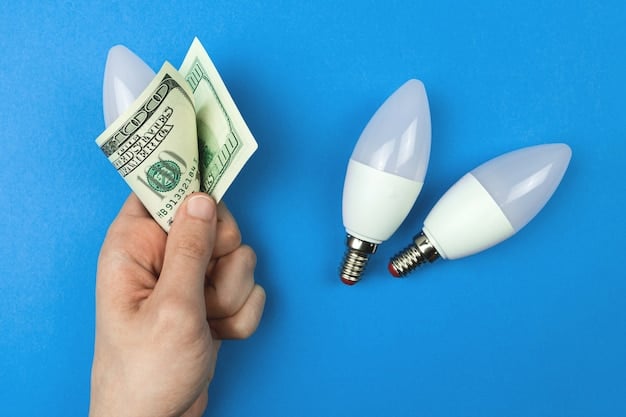Save $3,000 This Year: Top 5 Expense-Cutting Tips

Save $3,000 this year by implementing five key personal finance strategies, including budgeting, automating savings, reducing household expenses, negotiating bills, and maximizing rewards programs.
Want to save $3,000 this year without drastically changing your lifestyle? It’s more attainable than you might think! Let’s explore some effective and realistic personal finance tips to cut expenses and reach your savings goals.
Create a Budget and Track Your Spending
Creating a budget is the foundation of any successful savings plan. It allows you to see where your money is going and identify areas where you can cut back. Tracking your spending provides valuable insights into your financial habits, revealing hidden expenses and opportunities for savings.
Why Budgeting is Essential
Budgeting isn’t about restriction; it’s about empowerment. It gives you control over your finances and helps you make informed decisions about your money. Understand that having a budget helps you ensure your money is going towards what you want it to instead of what you think you need.
Tools for Tracking Your Spending
Numerous tools are available to help you track your spending, from simple spreadsheets to sophisticated budgeting apps. Find one that suits your needs and preferences to make the process easier and more effective.
- Mint: A popular budgeting app that automatically tracks your spending and categorizes your transactions.
- YNAB (You Need A Budget): A budgeting software that uses the envelope method to help you allocate your money and track your progress.
- Personal Capital: A financial dashboard that provides a comprehensive view of your finances, including budgeting, net worth tracking, and investment analysis.

By creating a budget and diligently tracking your spending, you’ll gain valuable insights into your financial habits and identify areas where you can save money. That includes spending such as daily coffee, restaurant meals and other items that can be cut without impacting your happiness.
Automate Your Savings
Automating your savings simplifies the process and makes it more likely that you’ll stick to your savings goals. By setting up automatic transfers from your checking account to your savings account, you can save money without even thinking about it.
Setting Up Automatic Transfers
Most banks and credit unions offer the option to set up automatic transfers between accounts. Determine how much you want to save each month and schedule regular transfers to ensure you reach your goals.
The Power of Compound Interest
Automating your savings allows you to take advantage of the power of compound interest. The sooner you start saving, the more time your money has to grow. Even small amounts saved consistently can add up to significant savings over time.
Automating even $25 a week will result in over $1300 by the end of the year, and continuing to do so for years results in big gains thanks to compound interest. Automating your savings removes temptation and helps you establish a consistent savings habit, allowing you to achieve your financial goals faster.
Reduce Your Household Expenses
Household expenses often account for a significant portion of your monthly budget. By identifying opportunities to reduce these expenses, you can free up more money for savings. Many strategies, from changing bulbs to canceling subscriptions you no longer use can free up cash for you to save.
Energy Efficiency Tips
Reducing your energy consumption can lead to significant savings on your utility bills. Implement energy-efficient practices in your home to lower your monthly expenses.
- Switch to LED bulbs: LED bulbs use significantly less energy than traditional incandescent bulbs.
- Unplug electronics when not in use: Many electronics consume energy even when turned off.
- Adjust your thermostat: Lowering your thermostat in the winter and raising it in the summer can save you money on heating and cooling costs.
Cutting Subscription Services
Subscription services can quickly add up, so review your subscriptions and cancel any that you no longer use or need. This can include streaming services, gym memberships, and other recurring expenses.

Reducing your household expenses requires a bit of effort, but taking action on this advice can free up hundreds or even thousands of dollars per year for savings. It also lowers your environmental impact.
Negotiate Your Bills
Negotiating your bills can be an effective way to lower your monthly expenses. Many service providers are willing to negotiate rates to retain customers. You will never know how much you can save unless you try it.
Negotiating with Service Providers
Contact your service providers, such as your internet, cable, and phone companies, and inquire about lower rates or promotional offers. Be polite and persistent, and be prepared to switch providers if necessary.
Lowering Your Insurance Premiums
Shop around for insurance quotes from multiple providers to ensure you’re getting the best rates. Consider increasing your deductibles to lower your monthly premiums. You can significantly decrease the amount coming out of your bank accounts just by calling to negotiate.
Negotiating your bills requires some time and effort, but the potential savings can be significant. You can also ask companies that allow you to subscribe to email lists to receive discounts if you do so, because that would benefit them as well.
Maximize Rewards Programs
Rewards programs, such as credit card rewards and loyalty programs, can help you earn cash back, points, or miles on your purchases. By maximizing these programs, you can effectively save money on everyday spending as well as big events such as traveling.
Choosing the Right Credit Cards
Select credit cards with rewards programs that align with your spending habits. Consider factors such as rewards rates, annual fees, and redemption options.
Utilizing Loyalty Programs
Take advantage of loyalty programs offered by your favorite retailers, restaurants, and other businesses. These programs can provide discounts, exclusive offers, and other perks.
By strategically maximizing rewards programs, you can effectively lower your expenses and save money on everyday spending. Rewards rates can vary substantially, so shop around before selecting the ones you will be using.
| Key Point | Brief Description |
|---|---|
| 💰 Budgeting | Track spending to find savings opportunities. |
| 🔄 Automate Savings | Set automatic transfers to simplify saving. |
| 💡 Reduce Expenses | Cut household and subscription costs. |
| 💳 Rewards | Use credit cards and loyalty programs wisely. |
Frequently Asked Questions
▼
Start by listing your monthly income and expenses. Use budgeting apps or spreadsheets to categorize your spending and identify areas where you can cut back. Review it weekly to make sure you aren’t getting off track.
▼
Switch to LED bulbs, unplug electronics when not in use, and adjust your thermostat to save on energy bills. Also, consider canceling unused subscription services to cut recurring costs.
▼
Contact your service providers and inquire about lower rates or promotional offers. Be polite and persistent, and be prepared to switch providers if necessary to get a better deal.
▼
Look for credit cards with rewards programs that align with your spending habits. Consider factors such as rewards rates, annual fees, and redemption options to maximize your benefits.
▼
Automating savings simplifies the process and makes it more likely that you’ll stick to your savings goals. Set up automatic transfers from your checking account to your savings account each month.
Conclusion
By implementing these five personal finance tips – creating a budget, automating savings, reducing household expenses, negotiating bills, and maximizing rewards programs – you can effectively save $3,000 this year and achieve your financial goals.





